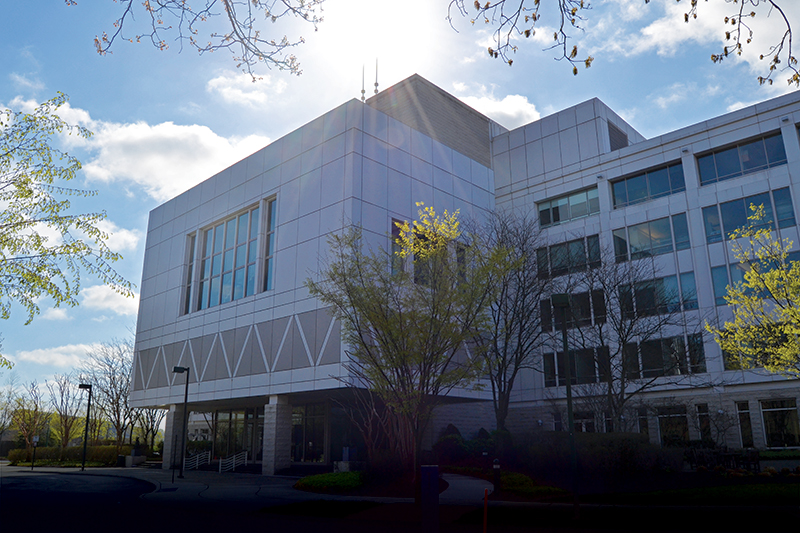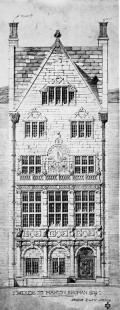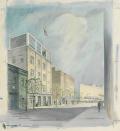Historical Ties: Creating an Organization to Serve Physicists
Spring
2015
Feature
Historical Ties: Creating an Organization to Serve Physicists
Tom Scheiding, Assistant Professor of Economics, University of Hawai'i - West O’ahu

At the headquarters of the American Institute of Physics (AIP) in College Park, Maryland, exists the Niels Bohr Library and Archives, where the histories of physics, astronomy, geophysics, and related fields are told in photographs, oral histories, personal papers, and original documents. Armed with research questions about what conditions and individuals led to the creation and initial years of AIP, I recently visited the library and perused over 4,000 pages of documents spanning four decades.
Members of the physics community are inclined to identify themselves with a particular scholarly society. They do not always know that most of these scholarly societies are collectively part of AIP, which represents 120,000 individuals who are members of ten scholarly societies, 24 affiliated societies, and three member organizations (including Sigma Pi Sigma). The story of AIP told here begins with the belief that in order for the discipline of physics to have grown as dramatically as it did in the 20th century (especially after WWII), there needed to be a scholarly organization like AIP that published scholarly literature, coordinated lobbying activities for research patronage, lent authority to research trends, and provided placement services for professionals.1
In the beginning
AIP was created through the joint efforts of physicists and the Chemical Foundation (CF), an organization created in 1919 to administer the 4,500 chemical and medicinal patents that German industries held in the United States preventing the manufacture of these products in the country. In the 1920s,2 many physicists affiliated with academia and industry belonged to the American Physical Society (APS). Those affiliated with academia believed that APS was not sufficiently specialized in its focus; they believed it was publishing too much industrial research. On the other hand, physicists affiliated with industry said that APS was devoting too little attention to industrial research problems, as industry financed more and more research.
To deal with the frustrations of its members, APS in 1930 initially attempted to copy the strategy that had been utilized by the American Chemical Society (ACS). ACS brought research communities under its purview during the 1920s by creating divisions that were part of the scholarly society but independent enough to meet the specific needs of specialized groups. APS formed the Committee on Applied Physics and the Committee on Affiliation with other Societies to discuss creating divisions.
Physicists had less success with this strategy than chemists, largely because scholarly societies such as The Optical Society (OSA), the Acoustical Society of America (ASA), and the Society of Rheology had already become too large and prominent to be relegated to a divisional status within another scholarly society.
Adding to the problem, APS was showing signs it could scarcely handle its own activities. Despite the fact that the Physical Review (PR) had grown in size by 250% between 1920 and 1929, authors faced longer publishing delays. Readers of PR received a journal that was larger in size and published more frequently. They were consequently overwhelmed by a general journal that was trying to be all things to all people. By the end of the 1920s, a number of industrial research laboratories began to publish their own journals, an activity that APS deplored.
The organizational problems that faced APS were compounded by financial issues. The revenue APS captured from readers of PR was insufficient to meet the journal’s publishing costs, and attempts to increase membership dues and subscription fees led to defections of readers and authors. The annual deficits generated by publishing PR accumulated, and patrons such as the Rockefeller Foundation and the National Academy of Sciences expressed an unwillingness to provide assistance.
What APS specifically and the physics research community more generally needed was a strategy that could control publication costs as well as deal with the industrialization and specialization of research. The physics community needed to be strengthened by building new infrastructure. This led to the design of AIP, an organization intended to help scholarly societies meet the needs of their members in an efficient fashion. AIP would publish and distribute journals, and carry out other collective activities. The result was that an individual scholarly society could continue to manage its own affairs and exert editorial control over its journals at a lower cost.
When considering what forces or institutions were most influential to forming AIP, historian Daniel Kevles of Yale University in New Haven, Connecticut, focuses on the role played by conversations among scholarly society officials. Physicists such as Karl Compton and Henry Barton cite, to varying degrees, the importance of the CF’s early financial and organizational support. The CF provided space for AIP’s headquarters, funds that allowed scholarly societies to transfer the publication of journals to AIP, monies to cover publication deficits, and subsidies of administrative costs for AIP.
The partnership between the CF and physicists was initiated by Charles Herty, who had served as president of ACS from 1915 to 1916. He edited the Journal of Industrial and Engineering Chemistry from 1917 to 1921 and served as president of the Synthetic Organic Chemical Manufacturer’s Association. In 1926 Herty was hired as a consultant to the CF. His initial task was to lobby for the creation of the National Institutes of Health and identify research projects that the CF should support.
Given Herty’s background, he initially encouraged the CF to direct funding to the ACS. The CF provided funding for publication deficits for ACS journals and the activities of ACS divisions that contributed to medicine and education. It began to devise a $10 million endowment that would be used by ACS for publications, research facilities, and outreach activities. The CF ceased most of its support to the ACS in 1929, due in no small part to personality conflicts between officers of the ACS and the CF. However, the CF continued to provide research support to medicine, education, and industrial applications.
On October 13, 1930, Herty and George Pegram met.3 Pegram, a physicist working with Compton on these issues, outlined three needs of the community: financing for PR’s publication deficits, initiating an abstract journal in physics, and supporting a better organization for scholarly societies. Herty responded that support for the abstracts journal was most likely to be done by the CF because of the journal’s value to academic and industrial researchers. The next most likely area of support would be funds to cover the publication deficits of PR. Herty believed that support for a new organizational structure would be more difficult.
On December 19, 1930, Pegram delivered to the CF an application that requested $12,000 to cover PR publication deficits, $8,000 for the abstracts journal, and $10,000 for a new journal titled Journal of Applied Physics, with no request made in the application for support for a new organizational structure.4 The request included letters of support from academics, medical professionals, and industry leaders who collectively cited the underinvestment that was occurring in physics.5
Francis Garvan (president of the CF), William Buffum (secretary and business manager of the CF), and Herty considered the application. On January 22, 1931, they announced their desire to provide financial and administrative aid to physics over the next 5–10 years, as well as their wish to place a priority on providing funding for the coordination of scholarly society activities (most notably, publications).6 As for the motivation behind the CF’s decision to make such a large investment in physics, Barton, in his narrative of the formation of AIP, remarks that the CF was of the view:
…that financial help could only be of maximum effect if it aided the whole of physics rather than if small bits were scattered among several unrelated enterprises. This view must be cited in the record because it was one of the strong arguments which brought the societies together in the Institute.7
This decision by the CF prompted nine physicists (three each from the APS, OSA, and ASA) to come together on February 27, 1931, to discuss opportunities for aligning their activities and prioritizing the unification of the major physics scholarly societies in some way.8 Early on during the meeting the representatives of the scholarly societies agreed to form AIP to study “the common problem of the organizations representing physics in America and for undertaking thereafter such functions as the cooperating societies may assign to it.”9 Members of APS took on leadership roles within AIP, with Compton elected chairman and Pegram elected secretary.
While Pegram and Buffum focused on reforming the publication of journals in physics in the 1930s, Barton, as the newly hired director of AIP, focused on using AIP to help physicists publicize their activities, advocate collectively for more support, and balance the needs and interests of academic and industrial researchers. Reforming the publication of journals in physics consisted of consolidating publication operations and imposing a uniform format and page size. The individual scholarly societies transferred their journals to AIP, with the CF financing the transfer costs. Each society continued to own its journals after the transfer, retain all editorial control, and be financially responsible for surpluses and deficits. Each society also determined the subscription price and retained member dues. AIP collected nonmember subscription revenues and proceeds from sales of back issues. AIP also encouraged scholarly societies to use the page-charge pricing mechanism that was already being used by APS.10 Each scholarly society paid to AIP a fee based on the number of pages published for the society as a percentage of the total number of pages published and an additional 15% handling fee to finance AIP’s nonpublication activities. It was the 15% handling charge that ensured AIP would be able to finance an active agenda and eventually wean itself off of CF support.
In its philanthropy the CF had an interest in making scholarly journals more cost efficient and scholarly societies more responsive to researchers. As a promoter of industrial interests, the CF also had an interest in having journals that accommodated industrial research. With Garvan’s death in 1937 and the decline in royalty revenue for the CF as patents expired, CF patronage to AIP eventually ended. It had provided in those six years $52,191.13 (the equivalent of $851,000 today).
After only a few years of encouragement and resources from the CF, physicists had assumed complete control over and responsibility for AIP and brought about both a greater efficiency in operations and better responsiveness to community needs. In the early 20th century the United States was a place where the size of disciplines was small, the number of trained professionals was small, and research patrons were still sorting out the appropriate magnitude and motivation for their investments. By the interwar period the enlargement of disciplines had begun and was accelerated by WWII. By the 1960s disciplines such as physics had become “big.” The sudden and unpredictable nature of this expansion left many disciplines scrambling to manage their operations. Thanks to steps taken in the interwar period by physicists and the CF, the discipline of physics had a scalable infrastructure in the second half of the 20th century that could accommodate change as it occurred.
Founded 84 years ago, AIP has been able to adjust to changes in the journal-publishing environment, new patterns of research patronage, advances in technology, and ever-greater levels of research specialization. Today AIP is a strong federation of ten physics-based societies representing over 120,000 members. In 2013, AIP spun off its publications operations into a wholly owned subsidiary, AIP Publishing, in order to continue building efficiencies for scholarly journal publishing. American physics would not be what it is today without AIP’s infrastructure.
1 For a more extended discussion of the story of AIP, see Tom Scheiding (2013), “Building the Scholarly Society Infrastructure in Physics in Interwar America,” Studies in History and Philosophy of Science Part B: Studies in History and Philosophy of Modern Physics, 44(4): 450–463.
2 Three narratives exist about the formation of AIP: Karl T. Compton, “The Founding of the American Institute of Physics,” Physics Today 5, no. 2 (1952): 4–7; Henry A. Barton, “The Story of the American Institute of Physics,” Physics Today 9, no. 1 (1956): 56–66; and Daniel Kevles, The Physicists: The History of a Scientific Community in Modern America (Cambridge, London: Harvard University Press, 1995), 261, 274–275
3 Archives of the Chemical Foundation held at the American Heritage Center at the University of Wyoming. Box 128, Folder 20, APS Correspondence 1925–1933.
4 Archives of the Chemical Foundation held at the American Heritage Center at the University of Wyoming. George Pegram to Francis Garvan, 15 December 1930, ACF Box 128, Folder 20, APS Correspondence 1925–1933.
5 Archives of the Chemical Foundation held at the American Heritage Center at the University of Wyoming. Brief Application to Mr. Francis P. Garvan for Support of Research in Physics, 19 December 1930, ACF Box 128, Folder 20, APS Correspondence 1925–1933.
6 Archival papers of Henry A. Barton held at the Niels Bohr Library at the American Institute of Physics. George Pegram to Karl Compton, 22 January 1931, Box 3, Folder 4.
7 Archival papers of Henry A. Barton held at the Niels Bohr Library at the American Institute of Physics. APS, Barton, Box 69, Folder 4, page 19. This unabridged history is undated but likely written in 1952, given the surrounding documents.
8 From the APS there was Compton, Tate, and Pegram; from the OSA there was Jones, F. Richtmeyer, and Foote; and from the ASA there was H. Fletcher, H. Arnold, and F. Saunders.
9 Archival papers of Henry A. Barton held at the Niels Bohr Library at the American Institute of Physics. APS, Barton, Box 69, Folder 4, page 16.
10 The page-charge pricing mechanism financially facilitated growth in physics. For a history of this pricing mechanism, see Tom Scheiding (2009), “Paying for Knowledge One Page at a Time: The Author Fee in Physics in Twentieth-Century America,” Historical Studies in the Natural Sciences 39 (2): 219–247.


